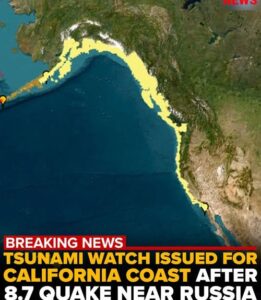Tsunami Alerts Issued Across U.S. West Coast After Massive 8.8 Quake Off Russian Coast

A powerful undersea earthquake struck off the coast of Russia’s Kamchatka Peninsula late Tuesday, triggering widespread tsunami alerts across parts of the Pacific, including the U.S. West Coast, Hawaii, Alaska, and several island territories.
According to the U.S. Geological Survey (USGS), the earthquake measured 8.8 on the Richter scale and occurred approximately 85 miles offshore, with its epicenter lying nearly 12 miles beneath the ocean floor. Initially measured as an 8.0 and later an 8.7, the event was upgraded after further analysis. Two strong aftershocks—one at magnitude 6.3 and another at 6.9—were also recorded soon after.
U.S. and Pacific Regions on High Alert
The seismic activity prompted immediate tsunami warnings for Alaska’s Aleutian Islands and the state of Hawaii. Meanwhile, tsunami advisories were issued for California, Oregon, Washington, Guam, and American Samoa, as emergency agencies assess the threat levels.
For California, the situation escalated from a Watch to a full Advisory. If tsunami waves form, experts predict they could reach the state’s shores by approximately 11:50 p.m., with the Los Angeles coastline expected to feel impact around 1 a.m. In anticipation, officials in Huntington Beach have proactively shut down the pier and local beaches.
In Hawaii, the first tsunami waves are forecast to hit the islands shortly after 7:15 p.m. local time, with authorities warning that significant and destructive wave activity is possible. Oahu’s Emergency Management office confirmed that its Emergency Operations Center is now fully activated, and Governor Josh Green’s administration is actively monitoring the situation through its Joint Information Center.
As part of Hawaii’s tsunami warning system, sirens are sounding statewide every 10 minutes for a three-hour period to alert residents and urge evacuations in at-risk zones.
Authorities have strongly advised all individuals in low-lying areas near the coast to evacuate to higher ground immediately. In Honolulu, people are being told to move outside of the evacuation zone or seek shelter in a building’s fourth floor or higher. The National Weather Service (NWS) has emphasized that all sides of the islands could be affected, as tsunami waves tend to curve around land masses.
“The threat doesn’t end with the first wave,” the NWS noted. “Tsunamis often bring multiple surges, and the most powerful wave may arrive later. Stay alert and stay away from the water.”
Japan Also on Edge
Japan’s Meteorological Agency has issued tsunami advisories across large stretches of its Pacific coastline—from Hokkaido in the north down to Kyushu in the south. The agency predicts that waves approximately 1 meter (3 feet) high could strike Hokkaido around 10:00 a.m. local time, with later arrivals expected further south along Honshu and Kyushu.
Japanese residents are being urged to avoid the coastlines and river mouths, and not to risk approaching the water to observe the incoming waves.

What the Alerts Mean
-
A Tsunami Warning means that dangerous, potentially life-threatening waves and coastal flooding are imminent or already occurring.
-
A Tsunami Advisory means that strong currents and minor flooding are expected, and people should avoid beaches, harbors, and marinas.
-
A Tsunami Watch indicates that an earthquake has occurred and a tsunami may be on its way, though confirmation is still pending.
This is a rapidly developing situation, and officials urge residents in all affected regions to follow updates from local emergency services, the USGS, and the National Weather Service.
Check back for the latest updates as more information becomes available.